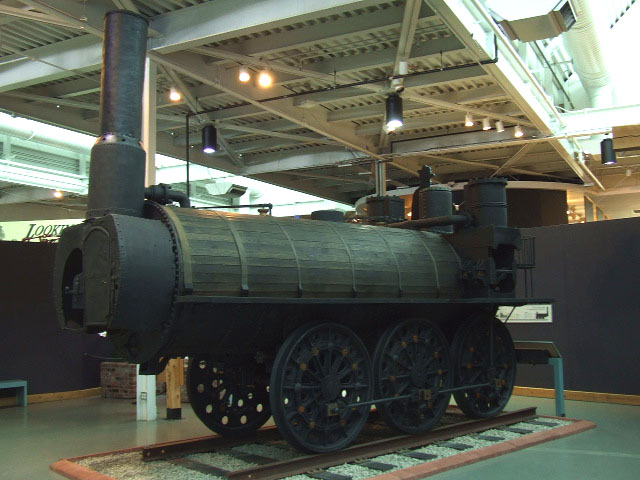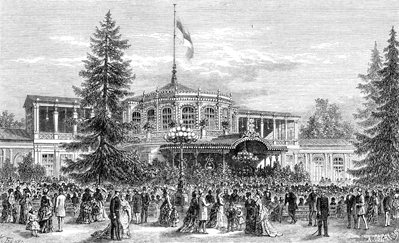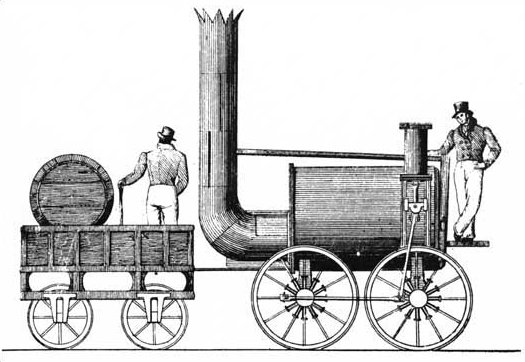|
Timothy Hackworth
Timothy Hackworth (22 December 1786 – 7 July 1850) was an English steam locomotive engineer who lived in Shildon, County Durham, England and was the first locomotive superintendent of the Stockton and Darlington Railway. Youth and early work Timothy Hackworth was born in Wylam in 1786, five years after his fellow railway pioneer George Stephenson had been born in the same village. Hackworth was the eldest son of John Hackworth who occupied the position of foreman blacksmith at Wylam Colliery until his death in 1804; the father had already acquired a considerable reputation as a mechanical worker and boiler maker. At the end of his apprenticeship in 1810 Timothy took over his father's position. Since 1804, the mine owner, Christopher Blackett had been investigating the possibilities of working the mine's short colliery tramroad by steam traction. Blackett set up a four-man working group including himself, William Hedley, the viewer; Timothy Hackworth, the new foreman smith an ... [...More Info...] [...Related Items...] OR: [Wikipedia] [Google] [Baidu] |
English People
The English people are an ethnic group and nation native to England, who speak the English language in England, English language, a West Germanic languages, West Germanic language, and share a common history and culture. The English identity is of History of Anglo-Saxon England, Anglo-Saxon origin, when they were known in Old English as the ('race or tribe of the Angles'). Their ethnonym is derived from the Angles, one of the Germanic peoples who migrated to Great Britain around the 5th century AD. The English largely descend from two main historical population groups the West Germanic tribes (the Angles, Saxons, Jutes and Frisians) who settled in southern Britain following the withdrawal of the Ancient Rome, Romans, and the Romano-British culture, partially Romanised Celtic Britons already living there.Martiniano, R., Caffell, A., Holst, M. et al. Genomic signals of migration and continuity in Britain before the Anglo-Saxons. Nat Commun 7, 10326 (2016). https://doi.org/10 ... [...More Info...] [...Related Items...] OR: [Wikipedia] [Google] [Baidu] |
Robert Stephenson
Robert Stephenson Fellow of the Royal Society, FRS HFRSE FRSA Doctor of Civil Law, DCL (16 October 1803 – 12 October 1859) was an English civil engineer and designer of locomotives. The only son of George Stephenson, the "Father of Railways", he built on the achievements of his father. Robert has been called the greatest engineer of the 19th century. Life Robert was born in Willington Quay near Wallsend, Northumberland, the son of George Stephenson and his wife, Frances Henderson. The family moved to Killingworth, where Robert was taught at the local village school. Robert attended the middle-class Percy Street Academy in Newcastle and at the age of fifteen was apprenticed to the mining engineer Nicholas Wood. He left before he had completed his three years to help his father survey the Stockton and Darlington Railway. Robert spent six months at Edinburgh University before working for three years as a mining engineer in Colombia. When he returned his father was building t ... [...More Info...] [...Related Items...] OR: [Wikipedia] [Google] [Baidu] |
Tsarskoye Selo Railway
The Tsarskoye Selo Railway (russian: Царскосе́льская желе́зная доро́га) was the first public railway line in the Russian Empire.Pushkin Encyclopædia Britannica on-line on-line (in Russian) It ran for from to Pavlovsk through the nearby (4 km) |
Shildon Railway Works
Shildon railway works opened in 1833 in the town of Shildon in County Durham, England. Originally built to serve the Stockton and Darlington Railway the works grew to cover ( roofed), employing 2750 staff. History Shildon was the terminus of the Stockton & Darlington Railway (S&DR), when it opened in 1825. Its first locomotive superintendent was Timothy Hackworth, who maintained their locomotives at the Soho Works. Thomas Hackworth (Timothy's brother) was works manager at the Soho Works. The beginnings of the works were small - In 1827, Timothy Hackworth built the locomotive Royal George at the Soho Works. It was also in this period that the works received an order from the Tsar of Russia for a locomotive. Shildon produced the engine and Hackworth's son John Wesley Hackworth was dispatched with drivers and mechanics to deliver it to Russia. These works were to be purchased by the S&DR company in 1855 and closed in 1883. Hackworth was the first of 22 managers of the wo ... [...More Info...] [...Related Items...] OR: [Wikipedia] [Google] [Baidu] |
Hammer Blow
In rail terminology, hammer blow or dynamic augment is a vertical force which alternately adds to and subtracts from the locomotive's weight on a wheel. It is transferred to the track by the driving wheels of many steam locomotives. It is an out-of-balance force on the wheel (known as overbalance). It is the result of a compromise when a locomotive's wheels are unbalanced to off-set horizontal reciprocating masses, such as connecting rods and pistons, to improve the ride. The hammer blow may cause damage to the locomotive and track if the wheel/rail force is high enough. Principles The addition of extra weights on the wheels reduces the unbalanced reciprocating forces on the locomotive but causes it to be out of balance vertically creating hammer blow. Locomotives were balanced to their individual cases, especially if several of the same design were constructed (a class). Each class member was balanced for its normal operating speed. Between 40% and 50% of the reciprocating weig ... [...More Info...] [...Related Items...] OR: [Wikipedia] [Google] [Baidu] |
Bolton And Leigh Railway
The Bolton and Leigh Railway (B&LR) was the first public railway in Lancashire, it opened for goods on 1 August 1828 preceding the Liverpool and Manchester Railway (L&MR) by two years. Passengers were carried from 1831. The railway operated independently until 1845 when it became part of the Grand Junction Railway. Background Bolton was situated on the Manchester, Bolton and Bury Canal and Leigh straddled a major east–west canal route, to the west ran the Leeds and Liverpool Canal and joined to it in the center of Leigh was the Bridgewater Canal running east. The canals provided freight routes to both Liverpool and Manchester. The canals of the time were the major freight routes being faster and able to transport greater loads than the carriers using the turnpike road system. But, unfortunately, these canal routes were slow, becoming congested, and increasingly more expensive as demand from the rapidly expanding businesses in the area increased. The waterways had a virtual m ... [...More Info...] [...Related Items...] OR: [Wikipedia] [Google] [Baidu] |
Sans Pareil
''Sans Pareil'' is a steam locomotive built by Timothy Hackworth which took part in the 1829 Rainhill Trials on the Liverpool and Manchester Railway, held to select a builder of locomotives. The name is French and means 'peerless' or 'without equal'. While a capable locomotive for the day, its technology was somewhat antiquated compared to George and Robert Stephenson's ''Rocket'', the winner of the Rainhill Trials and the £500 prize money. Instead of the fire tube boiler of ''Rocket'', ''Sans Pareil'' had a double return flue. To increase the heating surface area, the two flues were joined by a U shaped tube at the forward end of the boiler; the firebox and chimney were both positioned at the rear same end, one on either side. ''Sans Pareil'' had two cylinders, mounted vertically at the opposite end to the chimney, and driving one pair of driving wheels directly - the other pair were driven via connecting rods, in the typical steam locomotive fashion. At the Rainhill ... [...More Info...] [...Related Items...] OR: [Wikipedia] [Google] [Baidu] |
National Railway Museum
The National Railway Museum is a museum in York forming part of the Science Museum Group. The museum tells the story of rail transport in Britain and its impact on society. It is the home of the national collection of historically significant railway vehicles such as LNER Class A4 4468 Mallard, Mallard, GNR Stirling 4-2-2, Stirling Single, LMS Princess Coronation Class 6229 Duchess of Hamilton, Duchess of Hamilton and a Japanese Shinkansen, bullet train. In addition, the National Railway Museum holds a diverse collection of other objects, from a household recipe book used in George Stephenson's house to film showing a "People mover, never-stop railway" developed for the British Empire Exhibition. It has won many awards, including the European Museum of the Year Award in 2001. the museum is about to embark on a major site development. As part of the York Central redevelopment which will divert Leeman Road, the National Railway Museum will be building a new entrance building to c ... [...More Info...] [...Related Items...] OR: [Wikipedia] [Google] [Baidu] |
Stephenson's Rocket
Stephenson's ''Rocket'' is an early steam locomotive of 0-2-2 wheel arrangement. It was built for and won the Rainhill Trials of the Liverpool and Manchester Railway (L&MR), held in October 1829 to show that improved locomotives would be more efficient than stationary steam engines. ''Rocket'' was designed and built by Robert Stephenson in 1829, and built at the Forth Street Works of his company in Newcastle upon Tyne. Though ''Rocket'' was by no means the first steam locomotive, it was the first to bring together several innovations to produce the most advanced locomotive of its day. It is the most famous example of an evolving design of locomotives by Stephenson that became the template for most steam engines in the following 150 years. The locomotive was preserved and displayed in the Science Museum in London until 2018, after which it was displayed at the National Railway Museum in York. Design Overall layout The locomotive had a tall smokestack chimney at the ... [...More Info...] [...Related Items...] OR: [Wikipedia] [Google] [Baidu] |






